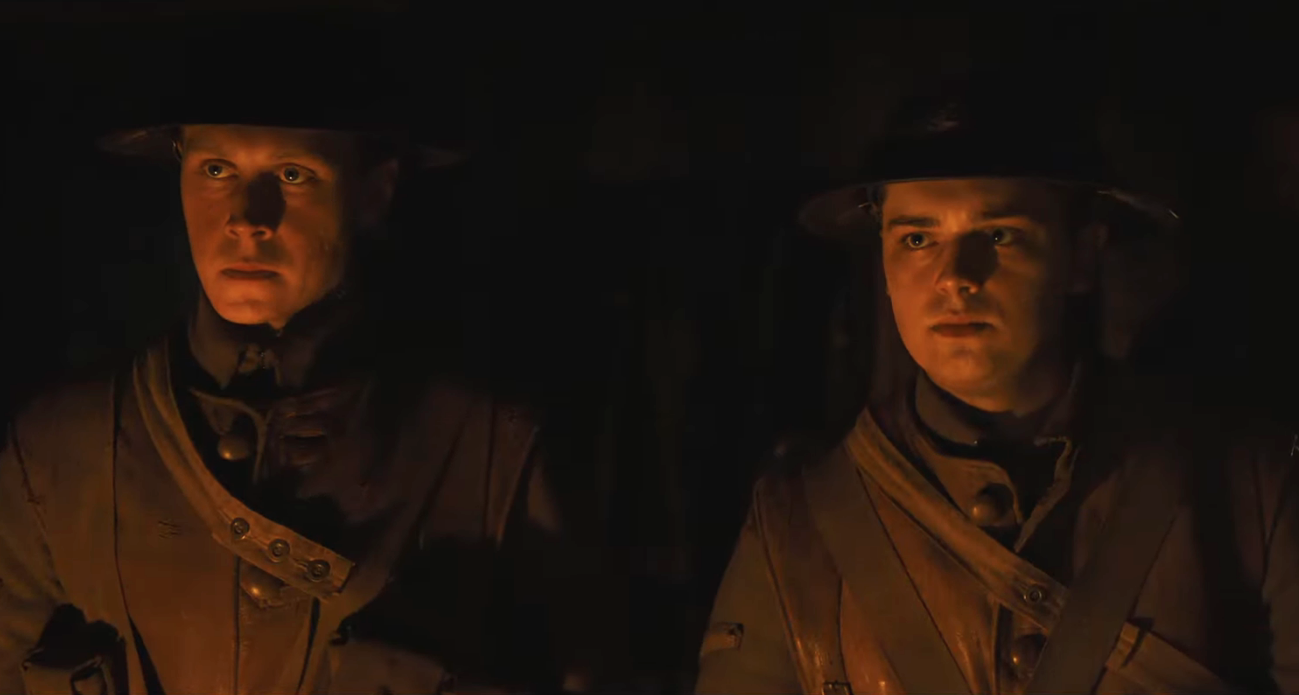

Part of the original Call of Duty games’ appeal was how its first person perspective embedded you directly in the conflict. Life or death stakes loomed over you at all times and, unlike post-Modern Warfare 2 entries, you couldn’t comprehend the full scale of war, let alone win it singlehandedly. Sam Mendes achieves a similar perspective with his World War I film 1917, easily the best new war movie since Dunkirk. Its plot is so simple and deals with a conflict that, in the grand scheme of the entire war, would barely register on a history book. But you won’t be feeling that way while the story is being told through a single tracking shot.
This was 1917’s big selling point for me, adopting the ambitious camerawork of Rope and Birdman that follows two soldiers’ journey from one trench to another. In short: give Roger Deakins his Oscar, then all the Oscars he never received for other films. From the moment Lance Corporal’s Blake (Dean-Charles Chapman) and Schofield (George MacKay) leave their tree and enter the never-ending Western Front trenches- a clear callback to Stanley Kubrick’s masterpiece Paths of Glory– the camera follows them everywhere. Over the trench, into a German barrack, through a narrow trench full of Allied soldiers – we never leave their side.


Deakins’ masterful cinematography accommodates a simple plot that, when you think about it, could easily have been used for a military video game level. On April 6, 1917, Blake and Schofield are ordered by General Erinmore (Colin Firth) to take an urgent message across No Man’s Land to the 2nd Devon regiment a few miles down. The Germans are laying a trap for them on the frontlines and, should they proceed with tomorrow’s attack, 1,600 men, including Blake’s brother, will be slaughtered. So they leave to do exactly that.
There’s little else to the plot, or even character development. But it’s not really needed. Much like Dunkirk, these characters are just avatars tasked with helping us experience this grueling journey across a terrain full of danger. A two-man squad, plus the camera POV that makes us the unofficial third wheel, to be precise. Mendes and Deakin masterfully let the audience feel like a part of the action, cautiously trudging alongside Blake and Schofield like another grunt involved in something beyond the scope of any one man. And, while the two characters don’t grow per se, their various conversations convey an army history that makes you believe they have each other’s back.
Really, 1917 is a one-two man show. Yes Firth, Mark Strong and Benedict Cumberbatch are cast as generals, but their roles are beyond brief. All three, plus a few other big name actors, show up for essentially 3-5 minute cameos and that’s about it. They’re just soldiers. Mendes rests his story in the hands of Chapman and MacKay, and they perform wonderfully in one of the most unique war films I’ve ever seen. Much like Paths of Glory, we rarely get a view of the German side (though soldiers are shown in a few scenes) and the Corporals almost never fire their guns, save for one sequence involving a sniper. But it’s never Saving Private Ryan-level bombastic thanks to the single tracking shot, which follows their movements at every turn. To use gamer speak: this has the setting of an FPS but the style of an artistic walking simulator.
The camerawork cannot be praised enough. At times 1917‘s “one shot” style feels like its jumping between the Russian Ark and Birdman setups: you always feel like these long takes must be cut somewhere, yet the camera just keeps rolling. Throughout its runtime I would watch ten to twenty minutes of footage unfold and scratch my head in awe as to where the hell Mendes could have ended one sequence to began another. None of these moments, however, hold back its nightmarish depiction of world war as so otherworldly that it literally inspired Mordor. Dead bodies, limbs and even horses lie spread out across No Man’s Land, while charred houses and destroyed buildings feel spread out like a maze. It’s not pretty and, when pulled into a geographical context, nearly insignificant.
![]()
![]()
Caution is essential for surviving outside the trenches. Rarely was there a moment in 1917 where the two soldiers aren’t aiming their guns because they, and by extension we, have no idea what’s up ahead. Whether it’s an underground German well or an abandoned farmhouse, something or someone can appear from nowhere and, to sound British, bollocks everything up. Thomas Newman’s score boosts this feeling of serene tension, mostly fading into the background to create an illusion of ambience before kicking straight into high adrenaline once a threat arises.
Had the film been shot conventionally, I would have derided its plot as cliched, even stale. But much like a great video game, the first person-lite camerawork enhances our immersion in this journey, making each bullet, explosion and footstep feel like it’s happening next to us. War is depicted rather minimally, but the objective remains the same: stay alive at all costs. Whatever it takes to complete your mission.
Verdict: 5 out of 5 Stars
1917 is a film you need to see in theaters, simply for the immersive continuous shot experience. Expertly paced, melancholic, and daunting from start to finish, it takes a simple order from a random battlefield and turns it into a pure trek for survival. I don’t think the film adds anything thematically different to the war genre, but Mendes’ technical ambition alone ensures that 1917 is destined to become a classic. And for god sake, give Roger Deakins his Oscar for Best Cinematography already!
